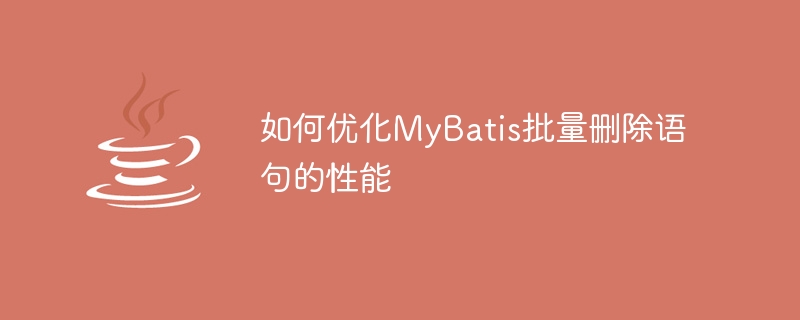

How to optimize the performance of MyBatis batch delete statements
MyBatis is a commonly used Java persistence layer framework, which provides great convenience for accessing relational databases. In actual development, we often encounter scenarios where we need to delete data in batches. How to optimize the performance of MyBatis batch delete statements is an issue that requires focus. This article will introduce some optimization techniques and provide specific code examples.
The sample code is as follows:
<delete id="batchDelete" parameterType="java.util.List">
DELETE FROM table_name
WHERE id IN
<foreach collection="list" item="id" open="(" separator="," close=")">
#{id}
</foreach>
</delete>The sample code is as follows:
<delete id="batchDelete" parameterType="java.util.Map">
DELETE FROM table_name
WHERE 1=1
<if test="ids != null and ids.size() > 0">
AND id IN
<foreach collection="ids" item="id" open="(" separator="," close=")">
#{id}
</foreach>
</if>
<if test="param1 != null and param1 != ''">
AND column1 = #{param1}
</if>
<if test="param2 != null and param2 != ''">
AND column2 = #{param2}
</if>
</delete>The sample code is as follows:
public void batchDelete(List<Integer> ids, int batchSize) {
int totalSize = ids.size();
int batchCount = totalSize / batchSize;
for (int i = 0; i < batchCount; i++) {
List<Integer> batchList = ids.subList(i * batchSize, (i + 1) * batchSize);
mapper.batchDelete(batchList);
}
if (totalSize % batchSize != 0) {
List<Integer> batchList = ids.subList(batchCount * batchSize, totalSize);
mapper.batchDelete(batchList);
}
}The sample code is as follows:
public void batchDelete(List<Integer> ids) {
sqlSession.getConnection().setAutoCommit(false);
try {
for (Integer id : ids) {
mapper.delete(id);
}
sqlSession.commit();
} catch (Exception e) {
sqlSession.rollback();
} finally {
sqlSession.getConnection().setAutoCommit(true);
}
}Summary:
By using optimization methods such as foreach tags, dynamic SQL, batch deletion and batch processing, it can be effectively improved Performance of MyBatis batch delete statements. In actual applications, appropriate optimization methods are selected according to specific business scenarios to achieve better deletion performance.
The above is the detailed content of Improve the efficiency of MyBatis batch deletion operations. For more information, please follow other related articles on the PHP Chinese website!
 what is optimization
what is optimization
 mybatis first level cache and second level cache
mybatis first level cache and second level cache
 Baidu keyword optimization software
Baidu keyword optimization software
 SQL statement to backup database
SQL statement to backup database
 Baidu SEO keyword ranking optimization method
Baidu SEO keyword ranking optimization method
 What is the difference between ibatis and mybatis
What is the difference between ibatis and mybatis
 How to configure database connection in mybatis
How to configure database connection in mybatis
 What is the working principle and process of mybatis
What is the working principle and process of mybatis




